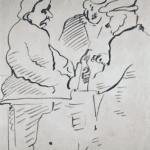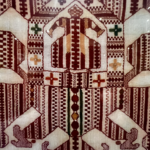Yaroslavl is an ancient Russian city on the upper Volga. Legend has it that in 1010, Prince Yaroslav of Kiev single-handedly killed a she-bear on the shore of the Volga river. To mark the spot, he built a small fortress that later grew into a town. The lucky hunt gave the city of Yaroslavl its name, its birth date and its coat of arms: a bear carrying the Prince’s golden axe. The brawny animal with an axe proved to be an appropriate emblem for the city. Many a time did Yaroslavians have to take up their battle-axes in defense of their city. They fought the raiding Tartar-Mongolian armies, and occasionally, the armies of neighboring Russian principalities. The union with the up coming Moscow in1463 proved to be beneficial for Yaroslavl. In the 16th century, Ivan the Terrible of Moscow subdued the unruly princes and conquered the lower Volga. The Volga of war and bloodshed became the river of peace and commerce.
Before railroads, rivers were the cheapest means to transport goods. What the Mississippi was to North America, the Volga river was to Russia. Yaroslavian merchants knew how to take advantage of the town’s strategic location. The tough Yaroslavians sailed down the river to the Caspian Sea to get exotic goods: silk, dyes, medicines. The more daring traveled to Siberia to get valuable Siberian furs. The most enterprising traders went north to the White Sea to do business with the London-based Muscovy company and the merchants of Amsterdam and Hamburg. European traders eagerly sought Russian wares: hemp rope and mast timber, cloth and tallow. High-quality Yaroslavian leather, iuft, was popular all over Europe.
Cultivating the virtues of literacy, piety and enterprise, the merchants of Yaroslavl were among the richest in Europe. The Yaroslavian wealth was amassed for a purpose. In 1613, the trading elites of Yaroslavl used their wealth to support a new ruling dynasty, the Romanovs. Their loyalty was recognized. Yaroslavians were granted trading privileges and the town entered its Golden Age.
Building a church has been a traditional way for the rich Russians to give back to the community and, at the same time, fulfill the goal of a Christian life. The merchants of Yaroslavl spared no expense to please the God of Christianity and distinguish themselves as citizens. Muralists covered entire church walls with frescoes. Icon-painters produced hundreds of exquisite icons for richly gilded iconostases. Icon-painting artels of Yaroslalvl were well known for their skill. They were often summoned to Moscow to do the Tsar’s commissions at the Moscow Kremlin. The royal patrons and common folk alike appreciated the distinct beauty of the Yaroslavian school.






You must be logged in to post a comment.